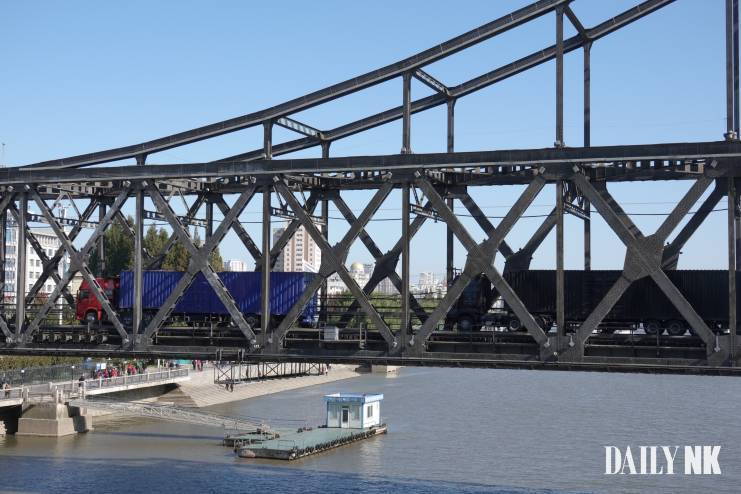In the early morning of Friday, Oct. 18, the road leading from Sinuiju, North Korea, to Dandong, China, was clogged with North Korean container trucks involved in Sino-North Korean trade.
The line of trucks stretched out towards the center of the 941-meter-long Sino-Korean Friendship Bridge (also known as the Yalu River Bridge). It was enough to cast into doubt any claims about a decrease in trade between North Korea and China arising from international sanctions.
At 8 AM, a number of North Korean cargo trucks were stationed on the bridge awaiting clearance, in time for the opening of the Dandong customs house. When the process began the trucks headed into the customs area one or two at a time. The procession lasted about an hour, as witnessed by Daily NK reporters.
GROWING SINO-NORTH KOREAN TRADE
According to the August 2019 monthly report on trends in trade between North Korea and China, published in September by the Industrial Bank of Korea’s North Korea Economic Research Center, North Korea’s total trade volume with China showed a 7.5% increase relative to the previous year.
This can be attributed to an increase in the trade of items not restricted by the sanctions following the rehabilitation of relations between North Korea and China, in part due to China’s President Xi Jinping’s visit to North Korea in June, Daily NK sources explained.
The worn-down North Korean trucks, after passing through customs, continued past downtown Dandong.
“They came to China to fulfill orders made in China,” a North Korea-based source told Daily NK. “They come in the morning and at night they are loaded with raw materials here in Dandong before heading back to North Korea.”
Products that were ordered in China are delivered in the morning, after which the trucks are loaded with raw materials in the evening before returning to North Korea, sources explained.

According to the Korea Trade Promotion Corporation (KOTRA), among the Chinese exports to North Korea in 2018, the export of hair and pipe tobacco had increased by 121.4% and 112.7%, respectively, relative to the previous year. A similar increase is expected this year, according to sources, just as last year, when the import of raw materials for manufacturing wigs and cigarettes showed a substantial increase.
By 8 PM, the sun had set and the number of passersby in the streets had dwindled, but the area in front of the Dandong customs house was crowded with a long line of North Korean trucks. When Daily NK counted the trucks as they inched by and through the customs house, more than 30 vehicles were counted in approximately 10 minutes. The trucks continued to enter the customs house, however, for long afterwards.
The long procession of trucks affected nearby traffic. Chinese law enforcement were restricting the flow of traffic and guiding the trucks into the customs area. Chinese pedestrians seemed accustomed to the trucks, stepping around them to cross the street.
Most of the trucks that entered the customs house area were semi-trailers, whose cargo could not be observed from outside. The ordinary cargo trucks without trailers seemed to be loaded with some sort of coiled metal. Iron and steel are banned by UN Security Council Resolution 2397. Although Daily NK reporters attempted to approach for a better look, they were stopped by Chinese law enforcement officers, for what appeared to be safety reasons.
SINUIJU’S GROWING IMPORTANCE IN CROSS-BORDER TRADE
All of the cargo trucks entering the customs house had license plates from North Pyongan Province. It is clear the materials traded between North Korea and China are brought to North Pyongan Province for distribution. The North Pyongan Province area, in this case, appears to be a distribution base of sorts for trade with China.

In fact, North Korea is preparing to promote Sinuiju in North Pyongan Province as the center of distribution and a relay station for trade. Already, some 70% of Sino-North Korean trade is estimated to occur on the road stretching from Sinuiju to Dandong.
An investment guide recently released by North Korea on investing in the border area of Sinuiju declares the country’s intention “to develop the financial industry, including bonded processing trade, service trade, commerce and the transit trade of supplies, securities, and stock exchanges, through entry points between North Korea and China (the Sino-Korean Friendship Bridge, the Yalu River Bridge, and the Port of Sinuiju).”
The guide announces that North Korea will build an international airfield and international port on the coastline of Cholsan and Yomju Counties, North Pyongan Province, and develop both air and sea transit infrastructure to make Sinjuiju International Economic Zone into a global distribution center.
As part of a special series focused on warming trade and exchanges between China and North Korea, Daily NK reported recently on the increase of Chinese tourism into North Korea.
*Translated by Violet Kim
Please direct any comments or questions about this article to dailynkenglish@gmail.com.





















